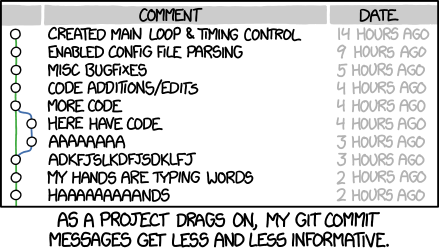Git is a free version control system which helps you keep track of file changes in your computer. Think of it as a time machine that lets you go back to any point in your project development.
While git is most used in software development, you can use it for anything you like (writing books, for example), as long as your files are plain text (e.g. source code, latex files), you won't have any issue with git (this guide is actually hosted using git, git-ception!).
Simply speaking, git saves snapshots of your work called commits, after a commit is done, you
can go back and forth to check the state of your project, maybe you were experimenting with some
new function and realized the old one was better, no problem, you can bring back anything!
The entire development of your project is stored in your computer, but we know that's dangerous, so you can also host a remote copy (just like you do with Dropbox or Google Drive).
There are many, many providers that let you store your git repositories (that's how you call a git project) but the most widely used is github (you'll be using it for dssg).
Apart from storing a copy of your projects, github comes with a lot of useful features. For example, you can use it to share your projects with your colleagues, so they can see (or modify if you want) your project.
Chances are, git is already installed on your computer. If not, you can get it from here.
OS X users: use homebrew, if you don't know what homebrew is, you probably didn't read the prerequisites :(
git is a command line tool, which means it doesn't have a graphical user interface. Using the git cli is the most flexible way of working with git, and if you are working on a remote serve (like in dssg) is best way of doing it.
However, if you still want a GUI (e.g. for using git in your computer), here are some options available:
- Options for Mac
- GitKraken (Windows and Mac)
- 15 minute tutorial to learn git - This is a must for people to get started.
- git - the simple guide - A simple guide to get to know the most important concepts.
- A successful git branching model - A model to work with git using branches. This model is widely used in the open source community.
- Learn Git Branching - Understanding what branches and rebases are, in an amazing interactive tutorial.
- Reset Demystified - A blog post on
git resetwhich develops some useful concepts along the way. - Understanding git for real by exploring the .git directory - A blog post on what's inside a commit.
- A git style guide, complete with branch naming, suggestions on how to handle commit messages, and more.
By default, git saves everything inside the folder where you initiated the repo. When working on software projects there are files you DON'T want to save on git (e.g. database passwords, especially if you have a remote copy).
To prevent git from saving files, create a file and name it .gitignore in the folder where you
ran git init. In such file, you can add rules to let git know what you want it to ignore. For
more information, read this.
Besides sensitive data, you want to also ignore intermediate files generated automatically by some programming languages or libraries. There are templates available depending on the tools you use. There's also a nice command line tool to fetch such templates.

